Jonathan Rockwell, Jr. (1711-1784)
Birth
This is the 305th anniversary of the birth of Jonathan Rockwell, Jr. He was born 31 March 1711 in Norwalk, Fairfield, Connecticut as the fourth child of Jonathan Rockwell and Abigail Camfield. He had three siblings, namely: Benjamin, John, and David. His family moved to Ridgefield, Fairfield, Connecticut when he was young. His father was one of the original land owners there.
Marriage and Children
When he was 22, he married Esther in Oct 1733 in Ridgefield, Fairfield, Connecticut, USA.
Jonathan Rockwell Jr. and Esther had the following children:
- Abigail Rockwell was born on 03 Feb 1734 in Ridgefield, Fairfield, Connecticut. She married Joseph Doolittle.
- Mary Rockwell was born on 09 Mar 1736 in Ridgefield, Fairfield, Connecticut. She married ___ Gray.
- Jonathan Rockwell was born on 10 Jan 1739 in Ridgefield, Fairfield, Connecticut. He married Hannah Bennett on 01 Jan 1760 in Ridgefield, Fairfield, Connecticut. He died in 1820 in Big Flats, Chemung, New York.
- Esther Rockwell was born on 10 Dec 1740 in Ridgefield, Fairfield, Connecticut. She married ____ Brown. She died before 1785 when her father’s estate was settled.
- Ebenezer Rockwell was born on 03 Sep 1742 in Ridgefield, Fairfield, Connecticut. He married Abigail Smith on 05 Nov 1777. He died on 04 Dec 1819.
- son Rockwell was born on 13 Dec 1743 in Ridgefield, Fairfield, Connecticut, USA.
- Elizabeth Rockwell was born on 15 Oct 1747 in Ridgefield, Fairfield, Connecticut, USA. She married __Jones.
- Henry Rockwell was born on 13 Dec 1749 in Ridgefield, Fairfield, Connecticut, USA. He died on 08 Mar 1814.
- Anna Rockwell. She married ____ Thomas.
- Dorcas Rockwell was born in 1753 at Ridgefield, Fairfield, Connecticut. She married Samuel Bostwick.
- William Rockwell was born about 1756 in Ridgefield, Fairfield, Connecticut, USA. He died on 21 Aug 1831 in Bungtown. He married Sarah Worden on 16 Jun 1785.
The Battle of Ridgefield
The American Revolution happened toward the end of Jonathan Rockwell Jr.’s life. He saw sons-in-law and his son William take an active part in that war. But, living in Ridgefield, Fairfield, Connecticut, the whole Rockwell family was surely affected. At the start of the Revolutionary War, Ridgefield only had about fifty dwellings and one main street called Town Street. Most of its 1700 residents lived in rural areas surrounding the town. On 27 April 1777, when Jonathan Rockwell Jr. was 66 years old, the town of Ridgefield became the site of Connecticut’s only inland battle of the Revolutionary War.
Early the day of the battle, Benedict Arnold arrived at Ridgefield with a hastily assembled group of about 500 Patriots. These were old men, young farm boys and the like, who had just been recruited. They were joined by a handful of Continental troops. Under Benedict Arnold’s command, they built a barricade at the Northern end of Town Street. They used timbers, carts, carriages, stones, earth and whatever else they could find to erect their barrier. Then they waited for the British troops to arrive.
The British had just attacked Danbury, Fairfield, Connecticut. There they had burned down the Colonial supply depot. When the British started on their mission they expected to have a lot of support from the locals, but were unpleasantly surprised when American forces closed in on Danbury from all directions. So, they made a quick 2 a.m. retreat from Danbury to head back to their ships at Compo Beach at Westport, Fairfield, Connecticut. They headed south and marched through Ridgebury and headed for Ridgefield in an attempt to avoid the Colonial army.
Meanwhile, the Colonial’s Major General David Wooster, with Generals Benedict Arnold and Gold Selleck Stillman, under his command were still planning to stop the British. Wooster split his troops. He sent most of the men with Arnold and Stillman to Ridgefield. He remained in charge of the rest to harass the British rear. About three miles north of Ridgefield, Wooster and his men surprised the British as they made a short stop for breakfast. They killed at least two redcoats and took about fifteen prisoners, and then vanished back into the woods.
An hour later,Wooster struck again, but this time the British were prepared and had three artillery pieces ready in the rear. Major General Wooster was mortally wounded and his inexperienced troops fled in confusion.
The British Column marched into Ridgefield after noon. They barraged the barricade with artillery fire and then “dispatched flanking parties to test both sides of the American position.” General Stillman had posted forces at either flank that held these initial British attempts. But, the British outnumbered the Americans three to one and they were trained and disciplined. At least 16 British soldiers were killed and 30 injured, but they breached the barricade and smashed both flanks and chased the Americas in a running battle down the length of Town Street. The British won and seized the town of Ridgefield.
At least twelve Patriots were killed and 24 injured. The Americans retreated under the personal direction of Benedict Arnold whose horse had been hit by musket ball collapsing on top of Arnold. The British camped the night just south of Ridgefield, then departed the next morning after burning six houses and the Episcopal Church (which was also being used as a Patriot supply depot).
Although the Danbury raid and Battle of Ridgefield were victories for the Crown, it caused Patriots to step up in greater number to defend Connecticut. In recognition for his contributions at the Battle of Ridgefield, Benedict Arnold received a promotion to Major General, and got a new horse.
Ridgefield, CT 06877
Westport, CT 06880
Death
Jonathan Rockwell Jr. died on 03 Sep 1784 in Ridgefield, Fairfield, Connecticut at age 73. His estate was settled in the Danbury Probate Court. An inventory of his estate leaves us with a glimpse into what a man who lived in the eighteenth century possessed. His most valuable possessions were his land, his house and his livestock. Note that the amounts are in pounds, shillings and pennies. So, for example, his yoke of oxen were valued at £10 (10 pounds) while his cow was worth £3-15-0 (3 pounds and 15 shillings).
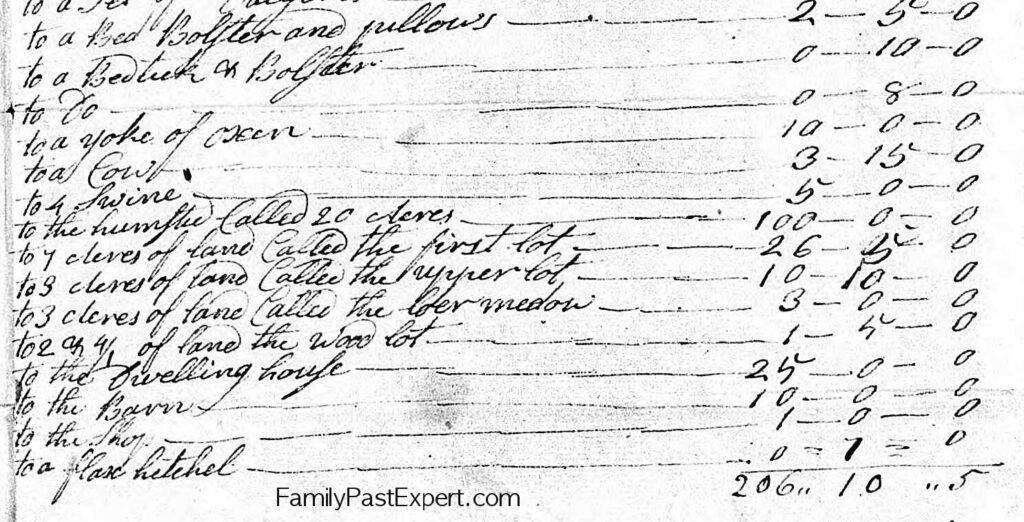
Everything listed was Jonathan’s property, and upon his death, the property of the estate, not the property of his wife. The widow, Esther Rockwell, didn’t own the tea kettle, the frying pan, the candlestick, the tables or chairs, the tablespoons or even the bed blankets.
Following are a couple samples of inventory of the estate of Jonathan Rockwell Jr.
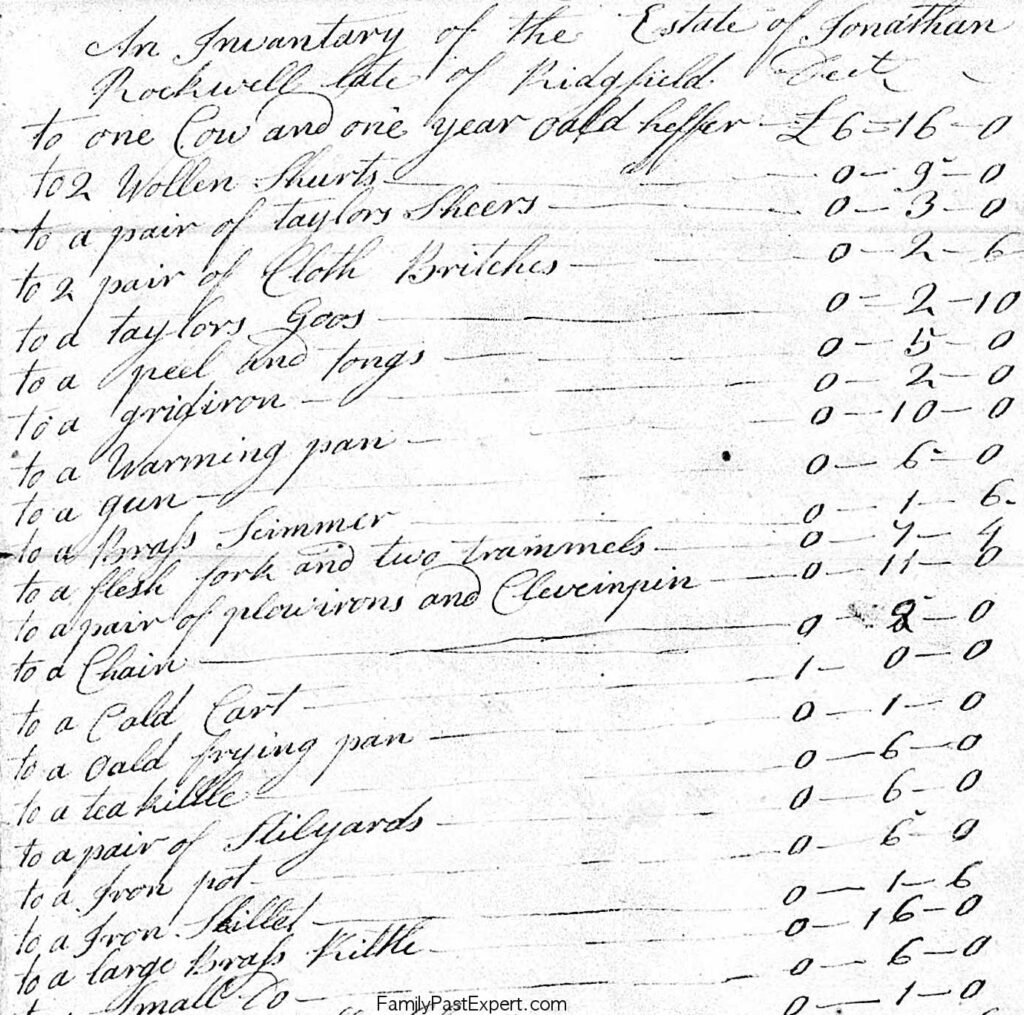
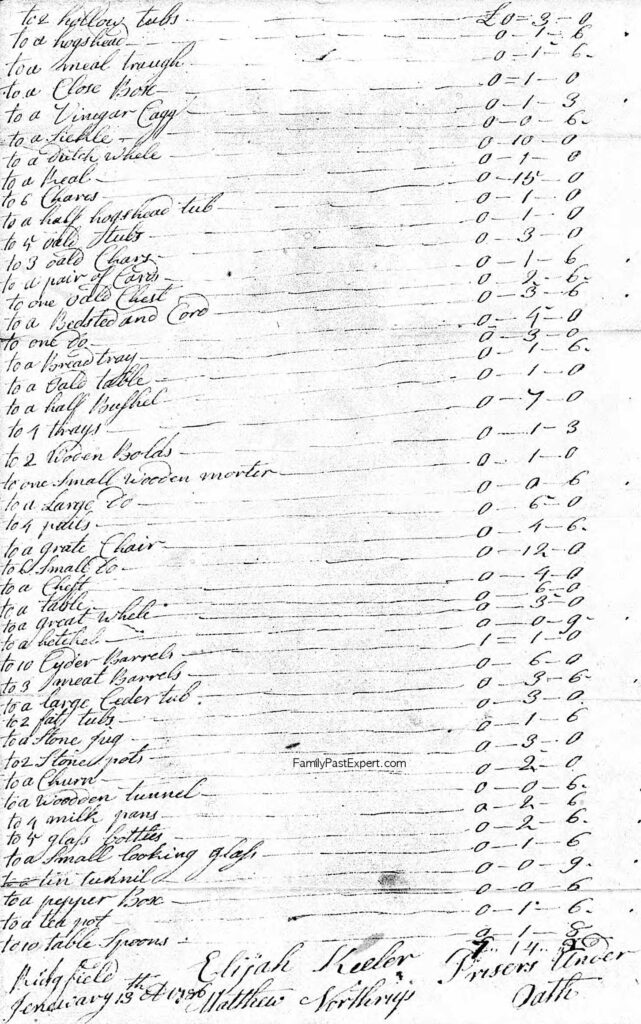
The Court of Probate finally ordered distributions from the estate to be made on 4 April 1790. As the widow and “relic” of the deceased, Esther Rockwell did receive “dower rights.” These were things bequeathed to her by the estate for her use during her lifetime unless she remarried. She received use of the east lower room of the dwelling house, the north half of the chamber next to that room and the privilege to pass in and out of that part of the house through the entryway. She got use of the north one third of the cellar under her room and the privilege to pass in and out of the cellar through the entryway. She also got use of the south half of the east bay of the barn and one third part of the floor way in the barn on the east side. Plus she got five acres and one rod of land. The area in the house was valued at £8-13-4, the area in the barn at £3-6-8, and the land at £31-16-1.
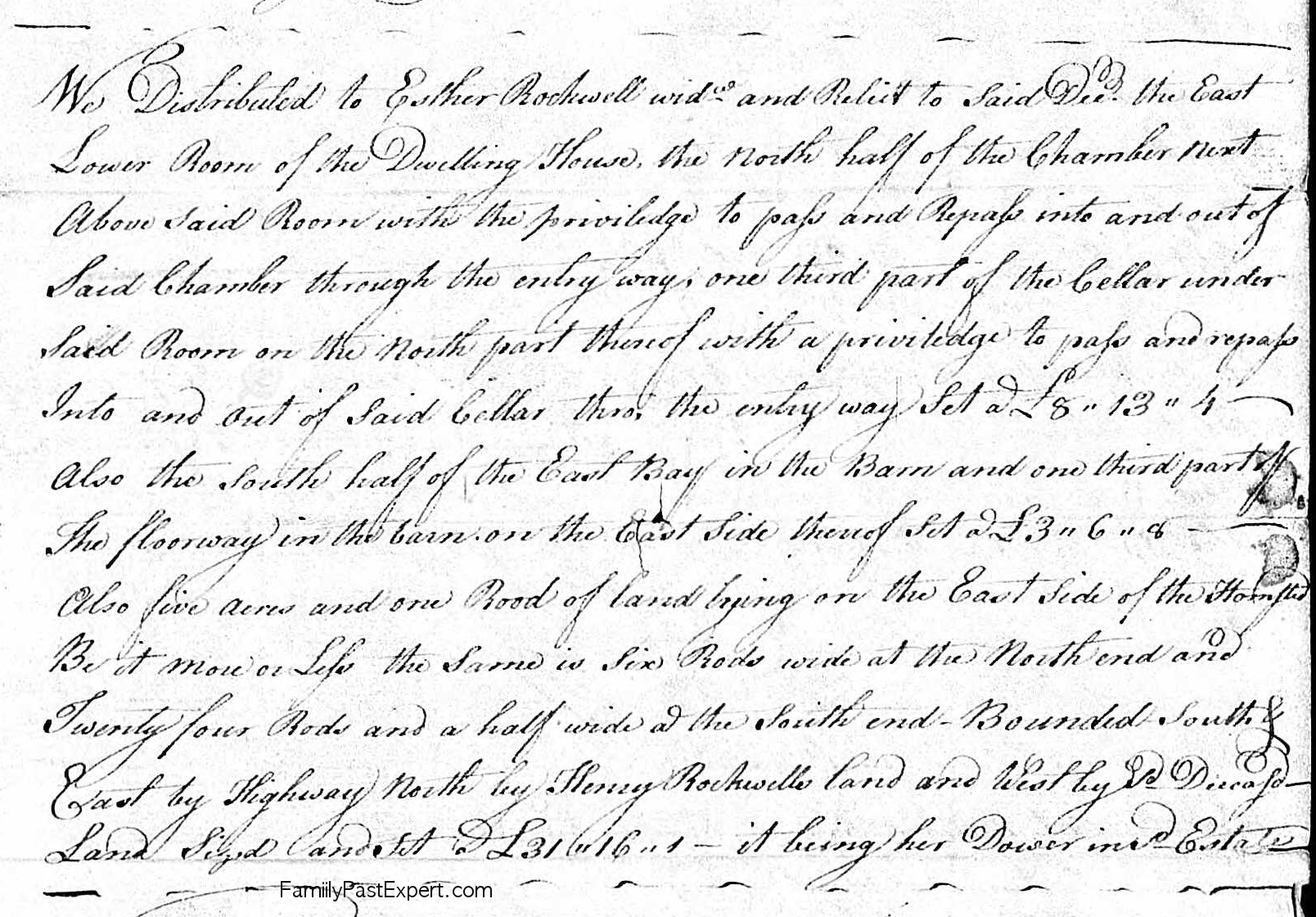
The rest of the estate was distributed to Jonathan and Esther’s sons and daughters. The widow did get the largest share of the estate to use in her widowhood.
As mentioned earlier, the area in the house was valued at £8-13-4, the area in the barn at £3-6-8, and the land at £31-16-1. Together that adds up to the £43.16.1 total. Twelve pennies equaled a shilling and twenty shillings equaled a pound, so the math does work out correctly.
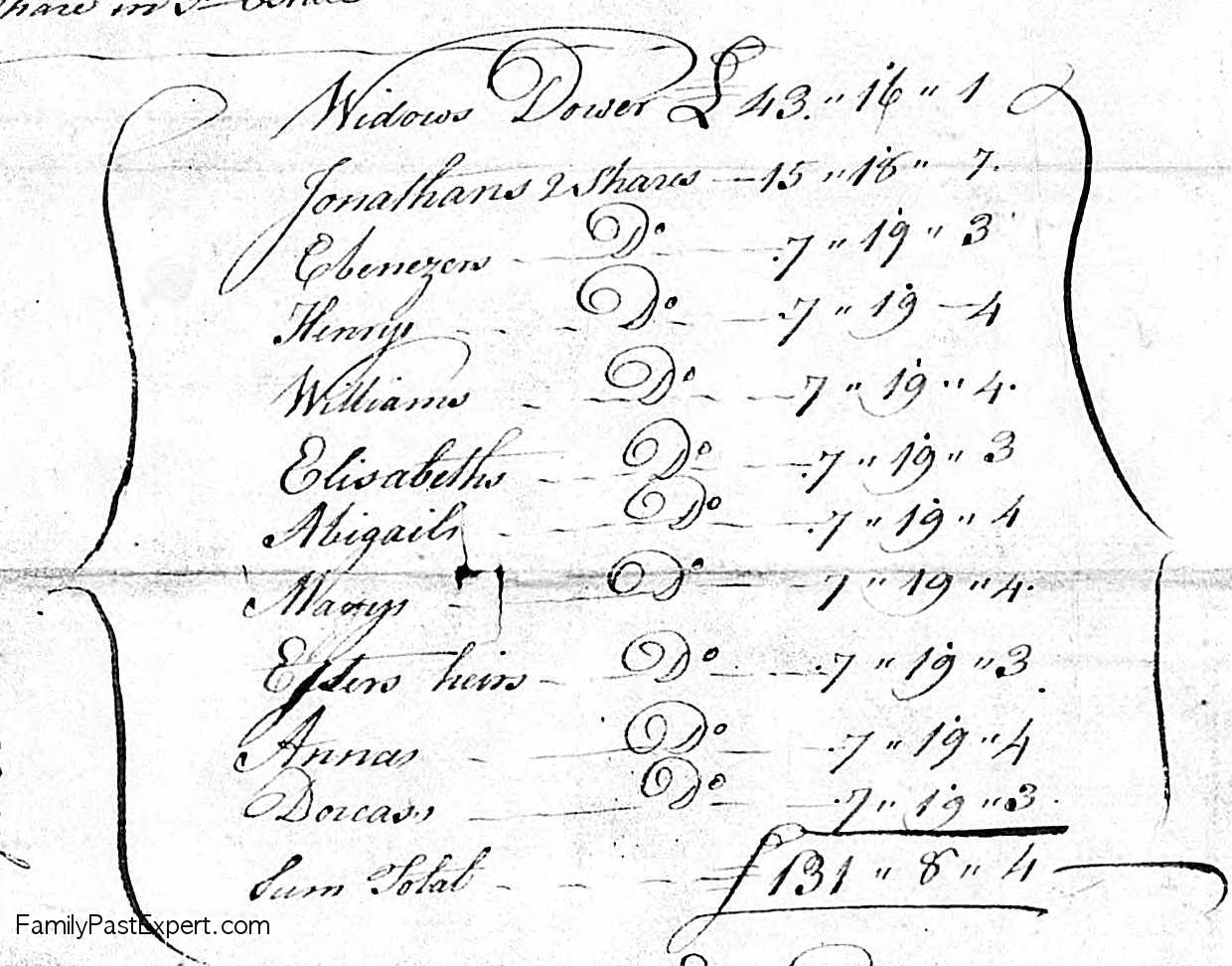
You may have noticed that Jonathan’s son Jonathan got a double share of the estate. This is simply because he was the oldest son. At the time, Connecticut was under multigeniture inheritance laws which meant that the estate would be divided among the children of the deceased, but they also followed what was called Mosaic law which held that a double portion would go to the eldest son. Lucky for us, the son with the extra share of the estate is in our family tree.
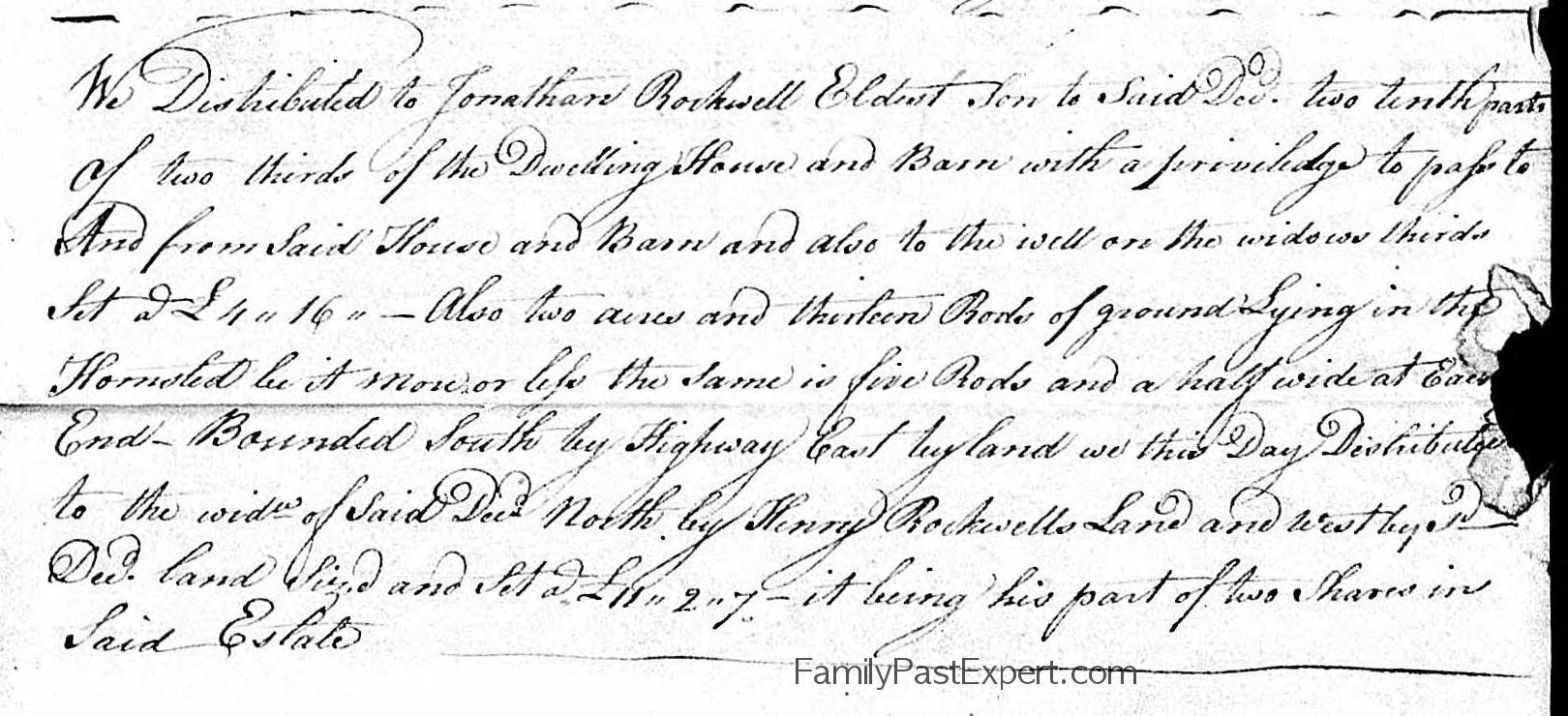
Where is he in the tree?
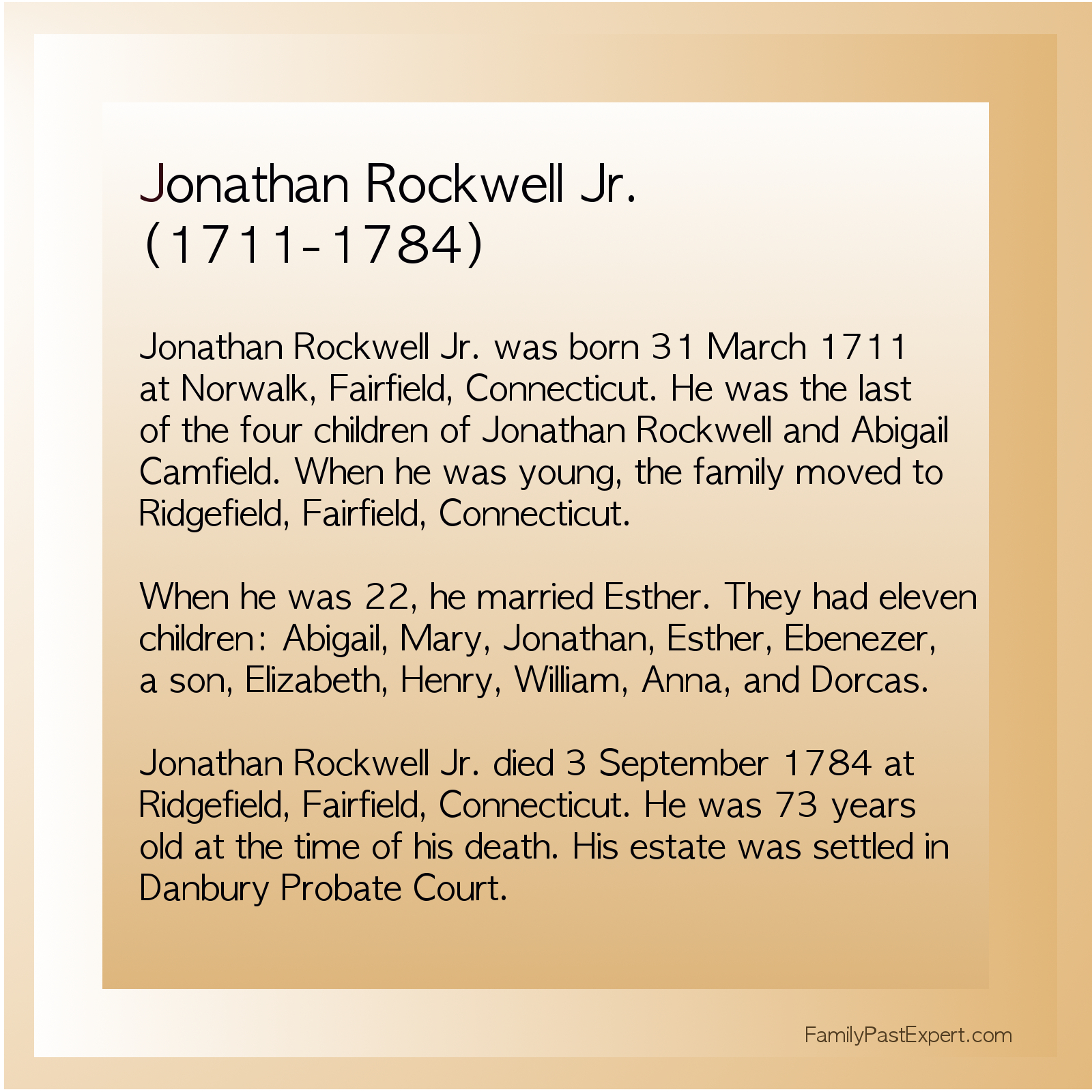
Sources:
Alston, Lee J. and Morton Owen Shapiro. “Inheritance Laws Across Colonies: Causes and Consequences.” Cambridge University Press: Economic History Association. 1984. Web. 30 March 2016. http//www.jstor.org/stable/2120705. Original source: The Journal of Economic History, Vol. 44, No. 2, The Tasks of Economic History (Jun., 1984), pp. 277-287.
“Battle at Ridgefield – Today in History: April 27.” ConnecticutHistory.org. Web. 30 March 2016. http://connecticuthistory.org/battle-at-ridgefield-today-in-history/.
Boughton, James, Genealogy of the families of John Rockwell of Stamford, Conn. [database on-line] (New York: W.F. Jones, 1903), ancestry.com, pp. 11, 23.
Denominations. The University of Michigan. Web. 30 March 2016. http://www.umich.edu/~ece/student_projects/money/denom.html.
Hickman, Kennedy. “American Revolution: Battle of Ridgefield.” 17 February 2016. Web. 30 March 2016. http://militaryhistory.about.com/od/AmRev1777/fl/American-Revolution-Battle-of-Ridgefield.htm.
Jones, Keith M. “The Battle of Ridgefield.” Ridgefield Connecticut. Web. 30 March 2016. http://www.ridgefieldct.org/content/42/249/1077.aspx.
Probate Files Collection, Early to 1880; Author: Connecticut State Library (Hartford, Connecticut); Probate Place: Hartford, Connecticut. Ancestry.com. Connecticut, Wills and Probate Records, 1609-1999 [database on-line]. Provo, UT, USA: Ancestry.com Operations, Inc., 2015. Original data: Connecticut County, District and Probate Courts.



Leave a Reply